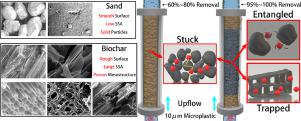Water Research ( IF 12.8 ) Pub Date : 2020-07-10 , DOI: 10.1016/j.watres.2020.116165 Ziheng Wang 1 , Majid Sedighi 2 , Amanda Lea-Langton 3

|
Extensive presence of microplastic pollution in the aquatic environment has recently been identified as a critical global challenge. A large proportion of the microplastic in aquatic environments originates from the effluent discharges from wastewater treatment plants and urban runoff. We present an experimental study on the removal of microplastic spheres using biochar as potential low-cost material for integration in sand filter systems to improve their efficiency for removing microbeads in wastewater treatment plants. Based on the results of a series of filtration tests and microscopic characterisation, the major mechanisms of interactions between the microplastic spheres and biochar and immobilisation processes are presented.
The results of leaching column tests on three biochar samples produced at three different temperatures from corn straw and a hardwood biochar are compared. The results show that the biochar filters provide significant capacity for the removal and immobilisation of 10 µm diameter microplastic spheres (above 95%) which is much larger than that of similar grain-sized sand filter studied. The extensive ESEM microscopic examination on the samples retrieved after the leaching tests show that the microplastic spheres were immobilised through three morphologically controlled mechanisms which are conceptualised to be ‘Stuck’, ‘Trapped’ and ‘Entangled’ whilst the microplastic spheres only ‘Stuck’ in sand filter. The presence of abundant honeycomb structures and thin chips to the high removal and immobilisation capacity of corn straw biochar produced at 500 °C and the hardwood biochar. In this study, we demonstrate that biochar can offer extensive potential for immobilisation of microplastic spheres (microbeads). This capacity can in principle be investigated and utilised to improve the efficiency of sand filters to remove microplastic in wastewater treatment plants.
中文翻译:

通过生物炭过滤微塑料球:去除效率和固定机制。
近来,水生环境中大量存在的微塑性污染已被视为全球面临的重大挑战。在水生环境中,很大一部分微塑料来自废水处理厂和城市径流的废水排放。我们提出了一项利用生物炭去除微塑料球的实验研究,该炭是集成在砂滤系统中的潜在低成本材料,以提高其去除废水处理厂中微珠的效率。基于一系列过滤测试和微观表征的结果,提出了微塑料球与生物炭和固定过程之间相互作用的主要机理。
比较了在三种不同温度下由玉米秸秆和硬木生物炭生产的三种生物炭样品的浸出柱测试结果。结果表明,生物炭过滤器具有很强的去除和固定直径为10 µm的微塑料球(95%以上)的能力,该能力比研究的类似粒度沙滤器大得多。对浸出试验后回收的样品进行的广泛ESEM显微镜检查表明,微塑料球是通过三种形态控制的机制固定的,这三种机制被概念化为“卡住”,“被困”和“纠缠”,而微塑料球仅被“卡住”在沙滤器中。丰富的蜂窝状结构和薄碎片的存在,对在500°C下生产的玉米秸秆生物炭和硬木生物炭具有很高的去除和固定能力。在这项研究中,我们证明生物炭可以提供固定化微塑料球体(微珠)的广泛潜力。原则上可以研究和利用这种能力,以提高滤砂器去除废水处理厂中的微塑料的效率。



























 京公网安备 11010802027423号
京公网安备 11010802027423号